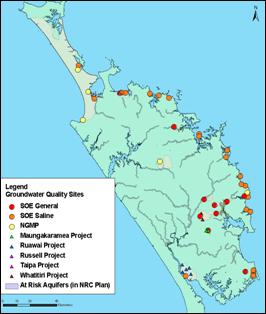Groundwater Quality
The Council monitors groundwater quality and change in water quality over time (trends). In Northland, the Council monitors seven sites through the National Groundwater Monitoring Programme. These sites have been sampled every three months since September 1996. The sites are located at Houhora, Paparore, Ahipara, Kaikohe, Tutukaka, Glenbervie and Tara. Samples are taken from each site and analysed for a range of components, such as nutrients, metals and bacteria.
In addition, the Council has its own State of the Environment (SoE) groundwater monitoring programme.
As part of this programme, 31 sites are sampled every three months. The aim of this programme is to collect information on water quality in each of the different aquifer systems in Northland and identify any changes over time, as well as the most likely cause of these changes. The map below shows the locations of groundwater quality sites monitored in Northland.

In general, groundwater in Northland is of a high enough quality that it can be consumed without treatment. During 2008-09, the results of groundwater quality monitoring indicated that the majority of samples taken complied with the standards for drinking water in New Zealand. However, some sites were found to have elevated levels of Iron, Manganese, bacteria and nitrates. The elevated Iron and Manganese levels measured in some of Northland's bores are the result of natural groundwater processes, while the elevated bacteria and nitrate levels are due to land use/human activity. The elevated nitrate levels at two sites have prompted specific groundwater investigations.
